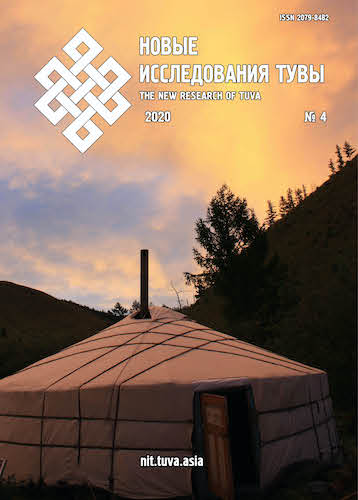Quantitative description of the pastoral economy of western Tuvan nomads
DOI:
https://doi.org/10.25178/nit.2020.4.2Keywords:
Tuva; Tuvans; nomads; animal husbandry; pastoralism; pastoralists; livestock farming; Inner Asia; economy of TuvaAbstract
Nomadic pastoralism persists at a substantial scale in Tuva and neighboring regions of Inner Asia. Tuvan pastoral lifeways reflect adaptations to both local environments and current economic realities. Much of our quantitative understanding of the economics of Tuvan nomads is derived from data collected in the first half of the 20th century. Accordingly, this paper provides an updated picture of the inner workings of nomadic households using data collected in Barun-Khemchik and Bai-Taiga provinces in 2013–2015. It analyzes herd composition and size, and compares the frequency of different animals kept today with values recorded in Tuva in 1916 and 1931. It then quantifies rates of provisioning hay and grain, and the production of meat and dairy products for consumption and sale. Finally, it characterizes typical costs of food, petrol, medicine, clothing, and school supplies faced by present-day herders. We advocate the collection of quantitative ethnographic data that can shed further light on the future of the Tuvan pastoralist niche.
References
Casimir, M. J. (1991) Flocks and Food: A Biocultural Approach to the Study of Pastoral Foodways. Köln, Böhlau Verlag. 327 p.
Chysyma, R. B. and Kuzmina, E. E. (2019) Innovatsionnoe razvitie zhivotnovodstva Respubliki Tyva [Innovative development of Animal Breeding in the Republic of Tuva]. Prirodnye resursy, sreda i obshchestvo, no. 1, pp. 59–65. (In Russ.).
Ermolaev, A. P. (1919a) Kratkii otchet ob issledovaniyakh v Uryankhaiskom krae v 1915–1918 [Brief report on research in the Uriankhai territory in 1915–1918.]. Sibirskie zapiski, no. 4–5, pp. 35–39. (In Russ.).
Ermolaev, A. P. (1919b) Uryankhaiskii krai (materialy dlya kharakteristiki Uryankhaiskogo kraya v torgovom otnoshenii) [Uriankhai territory: materials for the characteristics of the Uriankhai region in terms of trade)]. Minusink, Minusinsk Union of cooperatives. 27 p. (In Russ.).
Hooper, P. L., Demps, K., Gurven, M., Gerkey, D. and Kaplan, H. S. (2015) Skills, division of labour and economies of scale among Amazonian hunters and South Indian honey collectors. Philosophical Transactions of the Royal Society B: Biological Sciences, 370. DOI: https://www.doi.org/10.1098/rstb.2015.0008
Humphrey, C. and Sneath, D. (1999) The End of Nomadism? Society, State and the Environment in Inner Asia. Durham, Duke University Press. 355 p.
Osipova, V. (1961) Sel’skokhozyaistvennaya i demograficheskaya perepis’ 1931 g. kak vazhneishii istochnik kharakteristiki ekonomicheskogo stroya sel’skogo khozyaistva Tuvy [Agricultural and demographic census of 1931 as the most important source of characteristics of the economic structure of Tuva's agriculture]. Uchenyee zapiski Tuvinskogo nauchno-issledovatel’ skogo instituta yazyka, literatury, i istorii. Vol. 9, Kyzyl. Pp. 99–124. (In Russ.).
Sambuu, A. D., and Titlyanova, A. A. (2014) Vliianie sotsial'no-ekonomicheskogo razvitiia Respubliki Tyva na ee rastitel'nyi pokrov [The impact of socio-economic development of the Republic of Tuva on its plant cover]. Fundamental Research, no. 11 (3), pp. 550–555. (In Russ.).
Shiby, V. K. and Mishra, H. N. (2013) Fermented milks and milk products as functional foods — a review. Critical Reviews in Food Science and Nutrition, no. 53 (5), pp. 482–496.
Taibyl, R. S., Sevek, V. K., Sevek, R. M. and Darzhaa, Ch. B. (2019) Analysis of economic efficiency of livestock in the Republic of Tuva. IOP Conference Series: Earth and Environmental Science. Vol. 320 (1) [online] Available at: https://iopscience.iop.org/article/10.1088/1755-1315/320/1/012006
Tuvinskaya sel’skokhozyaistvennaya i demograficheskaya perepis’ 1931 goda [Tuva agricultural and demographic census of 1931] (1933). Moscow, published by the research Association for the study of national and colonial issues. 168 p. (In Russ.).
Vainshtein, S. I. (1980) Nomads of South Siberia: The Pastoral Economies of Tuva. C. Humphrey, Ed. Cambridge: Cambridge University Press. 289 p.
Published
How to Cite
Hooper P. L. Quantitative description of the pastoral economy of western Tuvan nomads. New Research of Tuva, 2020, no. 4, pp. 19-27. DOI: https://www.doi.org/10.25178/nit.2020.4.2
Для цитирования:
Hooper P. L. Quantitative description of the pastoral economy of western Tuvan nomads // Новые исследования Тувы. 2020. № 4. С. 19-27. DOI: https://www.doi.org/10.25178/nit.2020.4.2
Issue
Section

This work is licensed under a Creative Commons Attribution-NonCommercial 4.0 International License.

Author(s) license holder(s) grant rights for their work to the journal (grantee of a license) under the simple non-exclusive open license in accordance with Art. 1286.1 «Open license for a research work, work of literature or fine arts», Civil Code of the Russian Federation.
New Research of Tuva publishes articles under the Creative Commons Attribution-NonCommercial license (CC BY-NC).
Since it is an open license, author(s) reserve the right to upload the article to their institutional repository, submit it to another journal (if it allows republications), or republish it on their own website (in full, or in part).
However, several conditions apply here:
a) The republished version must always contain the name(s) and affiliation(s) of the author(s), the original title and the hyperlink to the original version on the New Research of Tuva website;
b) It must be in open access, free of charge, and no category of readers must be in any way whatsoever advantaged over general readership.
c) should the contribution be submitted elsewhere by its author(s) without substantial modification (30% or more of original text unchanged), the body of the article should contain a disclaimer that the original version was published in New Research of Tuva (with a link to the respective page)
The CC-BY-NC is a non-revocable license which applies worldwide and lasts for the duration of the work’s copyright.








